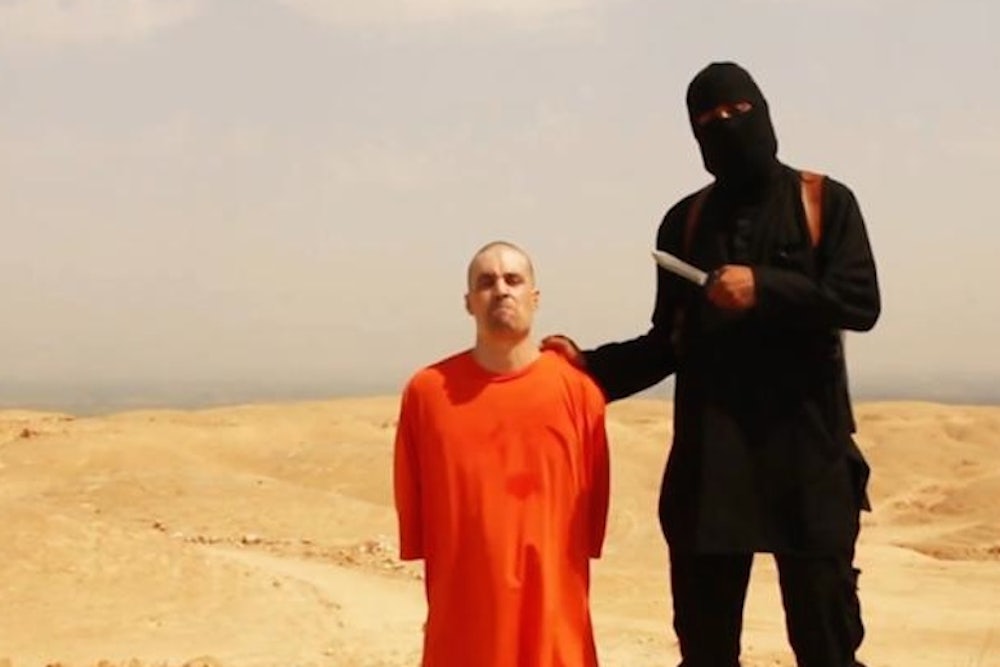The videotaped beheading of American journalist James Foley by an Islamic State militant has opened the eyes of the public to what Middle East experts have known for some time: As terrorists go, the barbaric, single-minded zealots of the Islamic State (aka ISIS or ISIL) are in a category all their own. Quartz’s Bobby Ghosh has compared them to Al Qaeda, the Khymer Rouge, and even the Nazis. The Nazi comparison should almost always be avoided, but the hyperbole is perhaps apt in this case. Just as the Nazis' unique brand of evil set it apart from other authoritarian and fascist movements, so is ISIS uniquely different from—and more malignant than—terrorist groups that have come before it.
The Islamic State now controls huge swaths of territory in Iraq and Syria, and continues to probe the borders of Iraqi Kurdistan and Lebanon. As my co-author Brian Fishman and I have noted even before the sweeping attacks on Mosul and Tikrit, ISIS is a de facto state and safe haven in which terrorists can train—an environment perhaps even more threatening than pre-9/11 Afghanistan. And they're only getting more popular, with thousands of new recruits joining just this month.
The genealogy of the Islamic State is now fairly well known. It has roots in various groups formed by Abu Musab al-Zarqawi after his release from a Jordanian prison in 1999. After time in Jordan and Afghanistan and possibly Kurdistan, Zarqawi founded a group called Monotheism and Jihad (abbreviated JTJ in Arabic). It was JTJ, and probably Zarqawi personally, that beheaded American businessman Nick Berg in Iraq in May 2004. In late 2004, JTJ pledged loyalty to Al Qaeda (despite longstanding tension between Zarqawi and Osama bin Laden) and became the Al Qaeda franchise in Iraq (AQI). Following Zarqawi’s death in 2006 by a U.S. airstrike, AQI suffered a series of defeats at the hands of both the U.S. military and the Sunni “awakening.” AQI was forced to largely retreat to its safe havens in Mosul, Tikrit, and the Sunni areas of Baghdad. In 2010, the death of Zarqawi’s successor led to the ascension of Abu Baqr al-Baghdadi, the current leader of the Islamic State. It was al-Baghdadi who moved the headquarters of the group to Syria at some point between 2011 and 2013, and in April of 2013 rebranded as the Islamic State in Iraq and Syria, rejecting the authority of Al Qaeda—a fact confirmed by Al Qaeda in February of this year when it formally eschewed any ties with ISIS.
The experience in Syria has transformed ISIS from a typical terrorist group to something quite different. As the world has now seen, it is able to fight set-piece conventional battles, not unlike Hezbollah. Having fought against both Hezbollah and Assad regime forces in Syria, this development should not have been unexpected. What was unexpected was the speed with which ISIS adapted and the degree of brutality brought. We had seen its predecessor organization enforce a strict reading of Sharia law, but that also happens in some Gulf States. But the list of atrocities committed by the Islamic State is shocking: We have reliable accounts of crucifixions, mass executions, slave markets, children buried alive, and of course the beheading of journalists. This is not to make light of other terrorist groups who are willing to kill innocent civilians to advance their aims. But these activities rise above “mere” killing. So while Hamas, to take a topical example, does aim its attacks at innocent civilians and therefore deserves its designation as a Foreign Terrorist Organization, it does not deliberately and with intent bury children alive or sell women as slaves to brothels.
These distinctions matter. Distinguishing between good and bad is easy, but here we are called to distinguish between bad and worse. There are many less-than-perfect actors in the Middle East, and even among the established states there are not a lot of stellar scores from Freedom House. This is not a region in which democracy has—to date—thrived.
But the Islamic State poses a unique threat. It seeks to disrupt the status quo of the region, and to do so in a manner certain to worsen the lives of the people of the region. This is no democratic protest, for which the status quo and stability might be sacrificed, but a violent theocratic movement. We can argue about the relative merits of the various non-democratic and non-liberal regimes in the region, but the Islamic State is clearly worse than any of the alternative forms of governance in the region, be it Iran or Saudi Arabia, and worse than any of the groups pushing for violent change in the region, such as the various Palestinian liberation groups.
The Islamic State is not just a threat to the Middle East; it's a threat to the U.S. homeland. Particularly since airstrikes started, but even before, the Islamic State has been clear about its long-term goal to attack America. Even if the organization itself does not manage to do so, returning “veterans” of ISIS with U.S. or European passports could set up domestic cells outside ISIS’s formal control—but with training, ideological motivation, and a connection to the global jihadist network.
Finally, the Islamic State is a serious enough threat that it has the potential to revise the map of U.S. allies and alliances in the region, upsetting longstanding tenets of Middle East diplomacy. States and groups, such as Iran or the PKK (a Turkish Kurd designated terrorist organization, but a key ally in rescuing the Yazidi at Sinjar), with less-than-friendly relations with the United States may find themselves encountering a détente, should they assist in the fight against ISIS. Likewise, traditional allies in the region, should they be found turning a blind eye to ISIS, could find their relationships reassessed.
This is the challenge the Obama administration must now confront.
